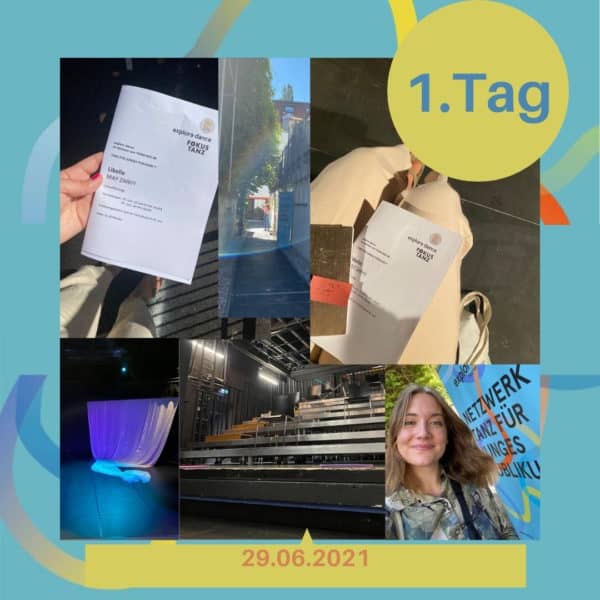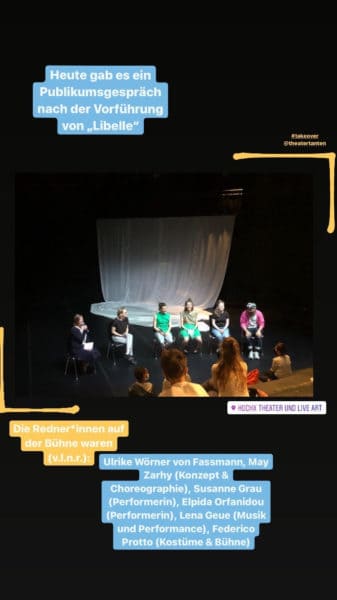
OF FAREWELLS, MIRACLE CREATURES AND SEXUAL CONSENT
THE THEATERTANTEN SHARE IMPRESSIONS AND THOUGHTS ON THE EXPLORE DANCE SECTION AT THINK BIG #8
By Julia Schleier und Theresa Spielmann | 13. August 2021
2/4 Theatertanten – Julia and Theresa – were on the road again for explore dance at THINK BIG! #8. As we are used to, we immerse ourselves with our whole being in the world of theatre and dance and share our experiences, which are naturally influenced by ourselves. Experiencing art and objectivity cannot be combined in our opinion, which is why we now write about our experience of explore dance at THINK BIG! #8 from our personal perspectives.
Like we’re all used to from explore dance, the productions are made for children and young people. That however, doesn’t mean that they can’t handle difficult issues. The productions deal with big and heavy concepts. von hier nach dort dissects the topic of farewell, XOXO asks “What are consent and intimacy”? And Libelle takes us into a world full of wonder and illusion.
After the performances in HochX and at schools, we talked to artists and performers or followed discussions with the audience, to find answers to the questions about the creation process and the experience of creating art for and with children.
LIBELLE (May Zarhy). HochX.
Julia.
Festival kick-off! May Zarhy’s Libelle (“Dragonfly”) premiered on 29 June at 10 am and marked the beginning of this year’s explore dance section at THINK BIG! #8. As the seats in the audience at HochX were of course limited for corona reasons, we “Theatertanten” split up this year and attended the performances mostly alone. I, Julia, was able to watch the opening piece and would like to take you with me into my very personal experience in the Libelle audience.

Children are sitting on my left, on my right, in front and behind me. At the very front, the two performers have mingled with the excited audience. The young spectators are still chattering away happily when the two women stand up and start playing with a sparkling fluffy ball, making it dance up and down their bodies. A child next to me realises, “They’re dancing!”
Yes, they are dancing! The fluffy ball makes rustling and jingling noises as it flies around wildly. Suddenly the performers – wait, are they still performers? or are we looking at two miraculous creatures now? – so let’s say the “miraculous creatures” and the fluffy ball suddenly hide under a big cloth. The audience shouts and says and whispers “OOH” and “UUI” and “HÄÄ” and there’s music, too.
The two performing beings move their bodies on the floor and they jump, wiggle, shake, turn, touch each other. The light changes and the child next to me asks, “Huh, now it’s pink?!” The audience really feels it, they receive and react so fast! When man-made noises and imitated animal sounds are made on stage, distorted or shrieked, chirped, shouted – the children imitate them. Not everyone though! Some sit quietly on their chairs, others bounce along, stomp on the floor or even try to move the chairs.
Long stories and short situations are created through facial expressions and gestures, through soft music or humming performers. Rather simple theatrical devices and stage tech such as different coloured light and shadow play first create an ocean-like atmosphere (to my right: “Woah, water!”, to my left: “A fish, I guess!”) and shortly afterwards already create a “MONSTER!” through growing shadows. Instruments like rattles or drums, costumes, lighting and a wind machine create a wondrous and magical overall picture.
I notice that the young audience members are fans of illusion. Shadow plays? Effective! A woman in an aluminium robe who becomes a crawling pile of aluminium foil? Funny! Just like the new colourful costumes with mirrors and light reflections at the end. Or the white cloth that looks like a pompous evening gown when gathered.
When the play is over, someone next to me asks into the silence and darkness, “Is it finished yet?” For me, it’s not. The lines „du bist älter als die Zeit – du Dino, du – deine Flügel sind dein Kleid – du Wunderwesen du“ that roughly translate into “you are older than time – you dinosaur, you – your wings are your dress – you miraculous creature you” from Lena Geue’s song about the play still ring in my ears for the rest of the day and name exactly what I saw on stage: immortal miraculous creatures.

After the show, I was able to ask May Zarhy a few quick questions. We’re including the resulting Insta-Story here:
After the performance on 30 June, there was also a talk with the audience, at which we “Theatertanten” were unfortunately not present. However, we do have some pictures for you:

If my impressions of Libelle have now sparked your interest, you can read Nico Grüninger’s journal article about Libelle here.
VON HIER NACH DORT (Lee Méir, André Lewski, Lidy Mouw). Grundschule am Karl-Marx-Ring.
Theresa and Julia.
On Thursday, July 1, we, Theresa and Julia, meet at 9 am at the Karl-Marx-Ring primary school. We are rarely out and about as early as we are this week. But that’s ok, because YAY, we get to see the performance von hier nach dort (“From here to there”). And by see we mean PARTICIPATE.

The fact that today’s performance is about goodbyes and that goodbyes are something that even the fourth graders at the primary school on Karl-Marx-Ring can relate to, becomes clear as we stand in front of the gym entrance and prepare for von hier nach dort together with the children. “Which small or big goodbyes have you already experienced?” It turns out that saying goodbye to the family every morning is more of a small goodbye, but moving from another city or country is more of a big one.
In the gym, all the children and all the adults put on an extra piece of clothing. A blazer or a big jacket, decorated with Velcro – as some kind of costume. André tells us afterwards that all the materials, all the costumes and all the props are and will be recycled. Even all the threads, which we and the school children knot, will be untangled afterwards. We connect each knot with a goodbye-story and tell each other about it. Not only are moves big goodbyes, but so is the death of family members or pets.
The whole performance is an up and down of thoughtfulness, sadness, but also happiness, gratitude and joy. Goodbyes to people, animals, things and decisions and all the positive and negative facets of goodbyes. We paint and write down what we will miss about the world when we leave it. We make farewell arrangements out of natural materials to finally be able to say goodbye to the people, animals, things and decisions we have not yet said goodbye to. Because the situation simply wasn’t right or because it was too difficult for us. But we also celebrate a happy farewell ceremony and attach rattles to our jackets, make noise with foil and recycled musical instruments.
By crafting and displaying the objects created, the big and small goodbyes are given an actual space in which they can finally take place. A landscape full of goodbyes, which we build up in the middle of the room and which we can look at. All of a sudden, the goodbyes are no longer as abstract and intangible as usual, but real and actual in front of us. It also shows that a goodbye looks different for everyone, but every form and every feeling is okay and good in this context.
The participatory play von hier nach dort deals with an important, omnipresent and yet little discussed topic in everyday life. The fourth graders will soon have to say goodbye to primary school, but they have already experienced so many more goodbyes that it seems incredibly valuable to talk about them in such a safe space. The children opened up, told their stories and the adults in the room joined in. No one was judged.

After the performance, the three artists took some time for us to ask a few quick questions. We have included the resulting Insta-Story here:
XOXO (Sebastian Matthias). HochX.
Theresa.
The last production we were able to see, or in this case me – Theresa, is XOXO by Sebastian Matthias. In front of HochX, it is already noticeable that the audience differs from that of the other productions. It is mainly young adults or slightly older teenagers who attend this performance. This is obviously due to the topic that is dealt with in this production. The performance is for young people from the age of 14, because the main themes are consent, sexuality and intimacy – what do mutual consent and intimacy actually mean and how do you talk about them?

On the path from the entrance to the assigned seats, all spectators walk past a series of exhibited objects. For this short time, it feels like visiting a museum. The objects often have something bizarre about them and are both numbered and titled. From candlesticks to electrically rotating feathers to popcorn machines and plants – all kinds of objects are part of the exhibition.
As soon as everyone is seated, things really start. The performers introduce themselves and get into the topic – talk about experiences and sexual issues that are uncomfortable for them. This removes any shame right away: Now, the performers can dance and speak without any embarrassment building up in the room.
During the performance, consent and intimacy are explained and shown verbally and in dance. This way it’s not only visually conveyed to the audience as a topic, but they are also given the vocabulary to facilitate a conversation about these topics. In the course of the performance, all the objects that were viewed at the beginning are brought onto the stage and incorporated into the movements and stories. They are not just props, but rather symbols or metaphors.
The performance shows that you can and must talk to young people and adults about all of these topics. Before the performance, I caught myself thinking “Consent and Intimacy are big words to tackle in a performance – that’s a brave choice.” And maybe that’s true, too, but Sebastian Matthias and the performers have found the right path between physicality and language and, above all, a space was created that is free from shame.
In a discussion with the audience after the performance, the pivotal keywords are taken up again: consent, intimacy and sexualities. During this conversation it becomes particularly clear that these topics are often pushed back and forth in our society: Who is responsible for an educational talk with children and young people – the parents or the school? Why is there only sex education in schools and no intimacy education? That is why these conversations have to be held everywhere, including the theatre, where there are more ways and means of communication available than elsewhere.
It becomes obvious in the conversation that the subject is everyone’s concern – not just regarding sexual contexts. The performers, for example, also set limits and communicated them in the group, before the rehearsals began: A conversation about consent can and must take place in all areas.






